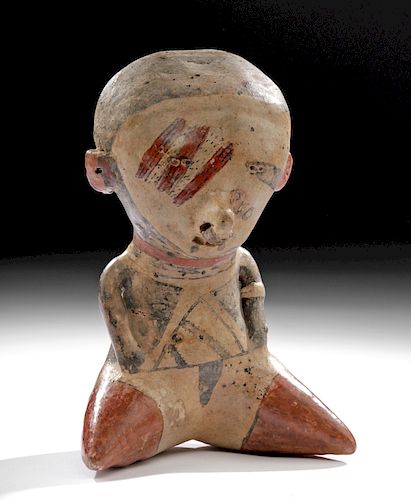Chinesco Polychrome Seated Figure w/ Heart Shaped Head
Lot 50b
About Seller
Artemis Fine Arts
686 S Taylor Ave, Ste 106
Louisville, CO 80027
United States
Selling antiquities, ancient and ethnographic art online since 1993, Artemis Gallery specializes in Classical Antiquities (Egyptian, Greek, Roman, Near Eastern), Asian, Pre-Columbian, African / Tribal / Oceanographic art. Our extensive inventory includes pottery, stone, metal, wood, glass and textil...Read more
Absentee vs Live bid
Two ways to bid:
- Leave a max absentee bid and the platform will bid on your behalf up to your maximum bid during the live auction.
- Bid live during the auction and your bids will be submitted real-time to the auctioneer.
Bid Increments
| Price | Bid Increment |
|---|---|
| $0 | $25 |
| $300 | $50 |
| $1,000 | $100 |
| $2,000 | $250 |
| $5,000 | $500 |
| $10,000 | $1,000 |
| $20,000 | $2,500 |
| $50,000 | $5,000 |
| $100,000 | $10,000 |
| $200,000 | $20,000 |
About Auction
By Artemis Fine Arts
Oct 3, 2019
Set Reminder
2019-10-03 10:00:00
2019-10-03 10:00:00
America/New_York
Bidsquare
Bidsquare : Exceptional Day 2: Pre-Columbian & Tribal Art
https://www.bidsquare.com/auctions/artemis-gallery/exceptional-day-2-pre-columbian-tribal-art-4453
Day 2 of an important 2-day auction featuring exceptional, museum-worthy examples of Pre-Columbian from the ancient Americas, Native American, African / Tribal, Oceanic, Spanish Colonial and fossils. Artemis Fine Arts info@artemisfinearts.com
Day 2 of an important 2-day auction featuring exceptional, museum-worthy examples of Pre-Columbian from the ancient Americas, Native American, African / Tribal, Oceanic, Spanish Colonial and fossils. Artemis Fine Arts info@artemisfinearts.com
- Lot Description
Pre-Columbian, West Mexico, Nayarit, ca. 300 BCE to 300 CE. An exemplary seated figure, its abstract, heart-shaped face comprised of tiny, oval eyes, a large, protruding nose decorated with a thick ornament, and a tiny, almost invisible slit for a mouth. The figure's sex is unclear but it may be a male based on the painted loincloth at the waist. His face is painted with wonderful decoration - diagonal red slashes over and around one eye and a thick black slash across the other eye and cheek. Do these represent clan tattoos, deliberate scarification, or even just decorative face paint? His body is painted with geometric motifs - triangles across the chest and arms, thick bands of earthy red on his legs, which are outspread in front of him and end in points. A single white armband is on one arm and a red band is painted around his neck. Size: 4.95" W x 6.65" H (12.6 cm x 16.9 cm)
This style of sculpture is known as Chinesco by collectors because of its stylistic similarities to Chinese art. Clay figures like this one are some of the only remains that we have today of a sophisticated and unique culture in West Mexico - they left no above-ground monuments or sculptures, at least that we know of, which is in strong contrast to developments elsewhere in ancient Mesoamerica. Instead, their tombs were their lasting works of art: skeletons arrayed radially with their feet positioned inward, and clay offerings, like this one, placed alongside the walls facing inward, near the skulls.
In 1974, Hasso von Winning published an exhaustive classification of Western Mexico shaft tomb artifacts (including, for example, the Chinesco A through D types), a classification that is still in use today. This example is similar to the first published Chinesco figure, attributed to Jalisco, Nayarit (Lumholtz, 1902, vol. 2: 294). For other red, white, and black slipped figures of this type, see Hasso Von Winning (1974) "The Shaft Tomb Figures of West Mexico." Southwest Museum Papers, no. 24. Los Angeles: Southwest Museum, figures 315 and 317.
Provenance: ex-private southern California, USA collection
All items legal to buy/sell under U.S. Statute covering cultural patrimony Code 2600, CHAPTER 14, and are guaranteed to be as described or your money back.
A Certificate of Authenticity will accompany all winning bids.
We ship worldwide and handle all shipping in-house for your convenience.
#150175Intact, with excellent preservation of motifs and pigment. Light manganese deposits overall.Condition
- Shipping Info
-
All shipping is handled in-house for your convenience. Your invoice from Artemis Gallery will include shipping calculation instructions. If in doubt, please inquire BEFORE bidding for estimated shipping costs for individual items.
-
- Buyer's Premium



 EUR
EUR CAD
CAD AUD
AUD GBP
GBP MXN
MXN HKD
HKD CNY
CNY MYR
MYR SEK
SEK SGD
SGD CHF
CHF THB
THB














